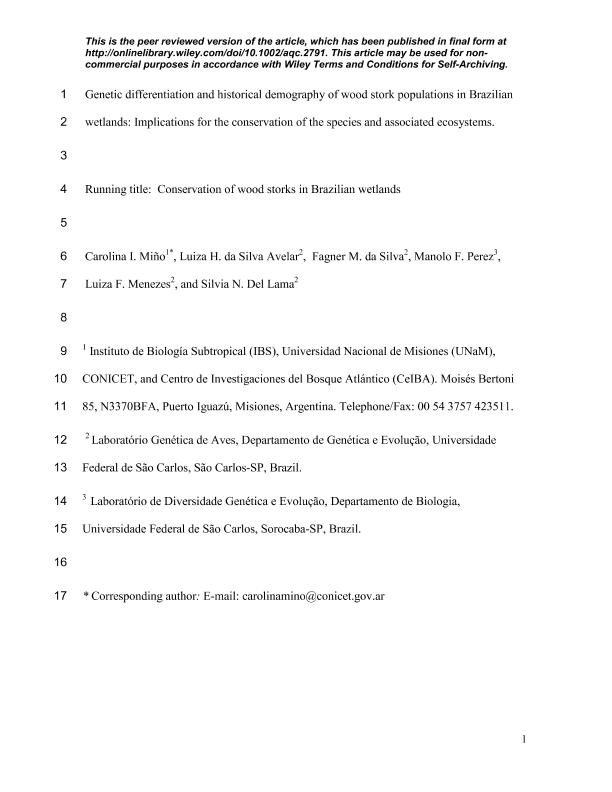Artículo
Genetic differentiation and historical demography of wood stork populations in Brazilian wetlands: Implications for the conservation of the species and associated ecosystems
Miño, Carolina Isabel ; Silva Avelar, Luisa H. da; Silva, Fagner M. da; Perez, Manolo F.; Menezes, Luiza F.; Lama, Silvia N. Del
; Silva Avelar, Luisa H. da; Silva, Fagner M. da; Perez, Manolo F.; Menezes, Luiza F.; Lama, Silvia N. Del
 ; Silva Avelar, Luisa H. da; Silva, Fagner M. da; Perez, Manolo F.; Menezes, Luiza F.; Lama, Silvia N. Del
; Silva Avelar, Luisa H. da; Silva, Fagner M. da; Perez, Manolo F.; Menezes, Luiza F.; Lama, Silvia N. Del
Fecha de publicación:
12/2017
Editorial:
John Wiley & Sons Ltd
Revista:
Aquatic Conservation: Marine and Freshwater Ecosystems
ISSN:
1052-7613
e-ISSN:
1099-0755
Idioma:
Inglés
Tipo de recurso:
Artículo publicado
Clasificación temática:
Resumen
Wetlands are increasingly threatened by human activities worldwide. Genetic monitoring of associated wildlife provides valuable data to support their conservation. Waterbirds such as the wood stork (Mycteria americana) are good bioindicators of wetland disturbance and destruction. This study investigated past and contemporary levels of genetic diversity, differentiation and demographic processes in 236 wood storks from two major wetlands in Brazil in which breeding colonies are concentrated, using nine microsatellite loci and a 237-bp untranslated fragment of the mitochondrial Control Region. Amapá populations (northern region) showed slightly higher levels of genetic diversity than Pantanal populations (central western region) and both populations had a low number of effective breeders. Results from assignment tests, F-statistics, AMOVA, spatial and non-spatial Bayesian clustering analyses support the hypothesis of gene flow among colonies within regions, but significant differentiation between regions. The better supported Bayesian coalescent models based on both markers indicated that the northern population exchanged migrants with unsampled populations, and that the central western population was founded by individuals from the north. Mitochondrial estimates revealed that the timing of population divergence broadly overlapped the Last Glacial Maximum (LGM), and that the central western population expanded more recently than the northern population. The results support the hypothesis that the coastal wetlands in northern Brazil remained stable enough to shelter large wood stork populations during the LGM and storks colonized freshwater wetlands in the central western region following deglacial warming. Conservation policies and protective measures should consider Amapá and Pantanal wood stork populations as genetically differentiated units and priority should be given to Amapá populations that represent the source gene pool. Continuous genetic monitoring of wood storks would help detect genetic signs of changes in demographic trends that may reflect alterations or degradation in wetlands.
Archivos asociados
Licencia
Identificadores
Colecciones
Articulos(CCT - NORDESTE)
Articulos de CTRO.CIENTIFICO TECNOL.CONICET - NORDESTE
Articulos de CTRO.CIENTIFICO TECNOL.CONICET - NORDESTE
Articulos(IBS)
Articulos de INSTITUTO DE BIOLOGIA SUBTROPICAL
Articulos de INSTITUTO DE BIOLOGIA SUBTROPICAL
Citación
Miño, Carolina Isabel; Silva Avelar, Luisa H. da; Silva, Fagner M. da; Perez, Manolo F.; Menezes, Luiza F.; et al.; Genetic differentiation and historical demography of wood stork populations in Brazilian wetlands: Implications for the conservation of the species and associated ecosystems; John Wiley & Sons Ltd; Aquatic Conservation: Marine and Freshwater Ecosystems; 27; 6; 12-2017; 1313-1324
Compartir
Altmétricas



